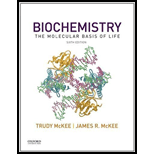
To analyze:
The maximum number of adenosine triphosphate (ATP) molecules generated from a mole of sucrose.
Introduction:
Glycolysis is a process in which glucose is broken down and gets converted to pyruvate. This process leads to the generation of energy. Energy is released in the form of ATP. These ATP molecules help in carrying out other reactions in the body.
Explanation of Solution
Sucrose is a disaccharide made up of two monosaccharides, glucoseand fructose.
For thebreakdown of one mole of glucose, ATP can be calculated at three stages.
1. Glycolysis: 6.5 ATP (2 ATP are utilized in the preparatory phase and 4 ATParereleased by substrate-levelphosphorylation. 4.5 ATPareproduced through the conversion of 2 nicotinamide adenine dinucleotide (NADH) to 2 NAD+ through oxidative phosphorylation)
2. Pyruvate to acetyl-CoA: 5 ATP (2 NADH are converted to 2 NAD+ and 5 ATP are released).
3. Citric acid cycle: 19.5 ATP (6 NADH produce 15 ATP, 2 flavin adenine dinucleotide (FADH2)produce 3 ATP through oxidative phosphorylation and 1.5 ATP molecules are produced through the formation of guanosine triphosphate (GTP) ).
Total ATP generated through glycolysis:
The number of ATP molecules generated during the breakdown of one mole of fructosecan be calculated at three stages.
1. Fructose
After forming fructose 6-phosphate from fructose by Hexokinase IV, it enters in gluconeogenic pathway.
2. Pyruvate to acetyl-CoA: 5 ATP (2 NADH are converted to 2 NAD+ and 5 ATP are released).
3. Citric acid cycle: 19.5 ATP (6 NADH produce 15 ATP, 2 FADH2 produce 3 ATP through oxidative phosphorylation and 1.5 ATP molecules are produced through the formation of GTP).
Total ATP generated through glycolysis:
The breakdown of one mole of sucrose will generate 31 ATP from glucose and 31 ATP from fructose.
Therefore, it can be concluded that the maximum number of ATP that can be generated from one mole of sucrose is 62.
Want to see more full solutions like this?
Chapter 10 Solutions
Biochemistry, The Molecular Basis of Life, 6th Edition
- You’ve isolated a protein and determined that the Native molecular weight of the holoenzyme is 160 kD using size exclusion chromatography. Analysis of this protein using SDS-PAGE revealed 2 bands, one at 100 kD and one at 30 kD. The enzyme was found to be 0.829% NAD (by weight). What further can be said regarding the structure of the polypeptide?arrow_forwardWhat is the formation of glycosylated hemoglobin (the basis for the HbA1c test)? Can you describe it?arrow_forwardPlease analze the gel electrophoresis column of the VRK1 kinase (MW: 39.71 kDa). Also use a ruler to measure the length of the column in centimeters and calculate the MW of each band observed. Lane 1: buffer Lane 2 : Ladder Lane 3: Lysate Lane 4: Flowthrough Lane 5: Wash Lanes 6-8: E1, E2, E3 Lane 9: Dialyzed VRK1 Lane 10: LDHarrow_forward
- Do sensory neurons express ACE2 or only neurolipin-1 receptors for COVID19 virus particle binding?arrow_forwardExplain the process of CNS infiltration of COVID19 through sensory neurons from beginning to end, including processes like endocytosis, the different receptors/proteins that are involved, how they are transported and released, etc.,arrow_forwardH2C CH2 HC-COOO CH2 ܘHO-C-13c-O isocitrate C-S-COA H213c CH2 C-OO 13C-S-COA CH2 C-00 the label will not be present in succinyl CoA C-S-COA succinyl-CoAarrow_forward
- A culture of kidneys cells contains all intermediates of the citric acid cycle. It is treated with an irreversible inhibitor of malate dehydrogenase, and then infused withglucose. Fill in the following list to account for the number of energy molecules that are formed from that one molecule of glucose in this situation. (NTP = nucleotidetriphosphate, e.g., ATP or GTP)Net number of NTP:Net number of NADH:Net number of FADH2:arrow_forward16. Which one of the compounds below is the final product of the reaction sequence shown here? OH A B NaOH Zn/Hg aldol condensation heat aq. HCI acetone C 0 D Earrow_forward2. Which one of the following alkenes undergoes the least exothermic hydrogenation upon treatment with H₂/Pd? A B C D Earrow_forward
- 6. What is the IUPAC name of the following compound? A) (Z)-3,5,6-trimethyl-3,5-heptadiene B) (E)-2,3,5-trimethyl-1,4-heptadiene C) (E)-5-ethyl-2,3-dimethyl-1,5-hexadiene D) (Z)-5-ethyl-2,3-dimethyl-1,5-hexadiene E) (Z)-2,3,5-trimethyl-1,4-heptadienearrow_forwardConsider the reaction shown. CH2OH Ex. CH2 -OH CH2- Dihydroxyacetone phosphate glyceraldehyde 3-phosphate The standard free-energy change (AG) for this reaction is 7.53 kJ mol-¹. Calculate the free-energy change (AG) for this reaction at 298 K when [dihydroxyacetone phosphate] = 0.100 M and [glyceraldehyde 3-phosphate] = 0.00300 M. AG= kJ mol-1arrow_forwardIf the pH of gastric juice is 1.6, what is the amount of energy (AG) required for the transport of hydrogen ions from a cell (internal pH of 7.4) into the stomach lumen? Assume that the membrane potential across this membrane is -70.0 mV and the temperature is 37 °C. AG= kJ mol-1arrow_forward
 Human Physiology: From Cells to Systems (MindTap ...BiologyISBN:9781285866932Author:Lauralee SherwoodPublisher:Cengage Learning
Human Physiology: From Cells to Systems (MindTap ...BiologyISBN:9781285866932Author:Lauralee SherwoodPublisher:Cengage Learning Anatomy & PhysiologyBiologyISBN:9781938168130Author:Kelly A. Young, James A. Wise, Peter DeSaix, Dean H. Kruse, Brandon Poe, Eddie Johnson, Jody E. Johnson, Oksana Korol, J. Gordon Betts, Mark WomblePublisher:OpenStax College
Anatomy & PhysiologyBiologyISBN:9781938168130Author:Kelly A. Young, James A. Wise, Peter DeSaix, Dean H. Kruse, Brandon Poe, Eddie Johnson, Jody E. Johnson, Oksana Korol, J. Gordon Betts, Mark WomblePublisher:OpenStax College Human Biology (MindTap Course List)BiologyISBN:9781305112100Author:Cecie Starr, Beverly McMillanPublisher:Cengage Learning
Human Biology (MindTap Course List)BiologyISBN:9781305112100Author:Cecie Starr, Beverly McMillanPublisher:Cengage Learning Concepts of BiologyBiologyISBN:9781938168116Author:Samantha Fowler, Rebecca Roush, James WisePublisher:OpenStax College
Concepts of BiologyBiologyISBN:9781938168116Author:Samantha Fowler, Rebecca Roush, James WisePublisher:OpenStax College





